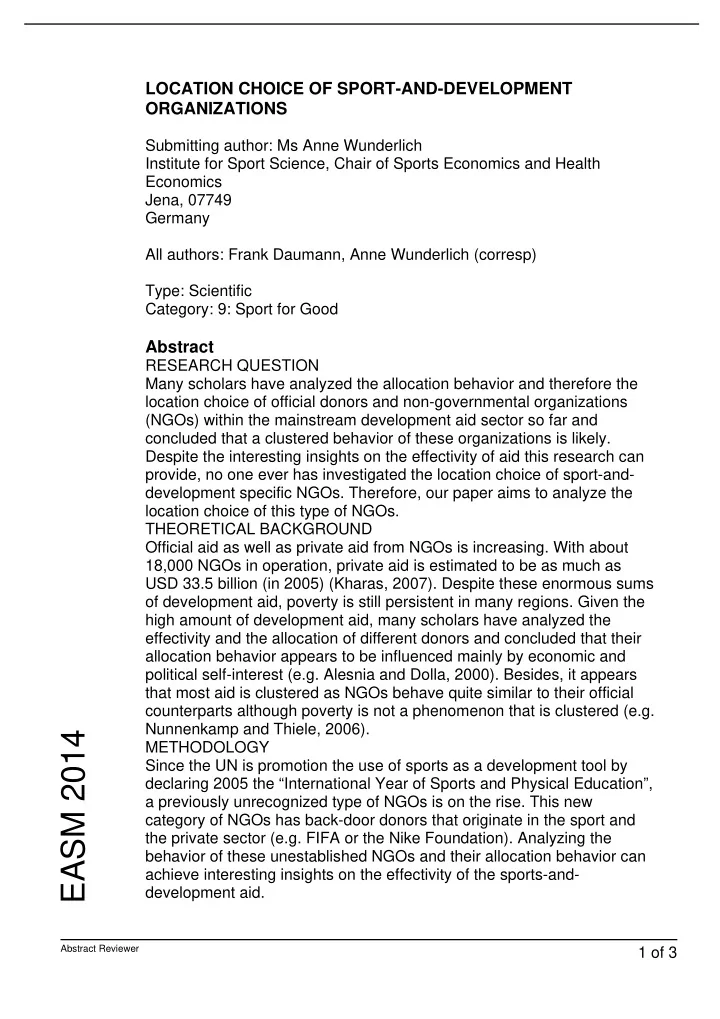

LOCATION CHOICE OF SPORT-AND-DEVELOPMENT ORGANIZATIONS Submitting author: Ms Anne Wunderlich Institute for Sport Science, Chair of Sports Economics and Health Economics Jena, 07749 Germany All authors: Frank Daumann, Anne Wunderlich (corresp) Type: Scientific Category: 9: Sport for Good Abstract RESEARCH QUESTION� Many scholars have analyzed the allocation behavior and therefore the location choice of official donors and non-governmental organizations (NGOs) within the mainstream development aid sector so far and concluded that a clustered behavior of these organizations is likely. Despite the interesting insights on the effectivity of aid this research can provide, no one ever has investigated the location choice of sport-and- development specific NGOs. Therefore, our paper aims to analyze the location choice of this type of NGOs.� THEORETICAL BACKGROUND� Official aid as well as private aid from NGOs is increasing. With about 18,000 NGOs in operation, private aid is estimated to be as much as USD 33.5 billion (in 2005) (Kharas, 2007). Despite these enormous sums of development aid, poverty is still persistent in many regions. Given the high amount of development aid, many scholars have analyzed the effectivity and the allocation of different donors and concluded that their allocation behavior appears to be influenced mainly by economic and political self-interest (e.g. Alesnia and Dolla, 2000). Besides, it appears that most aid is clustered as NGOs behave quite similar to their official counterparts although poverty is not a phenomenon that is clustered (e.g. Nunnenkamp and Thiele, 2006).� EASM 2014 METHODOLOGY� Since the UN is promotion the use of sports as a development tool by declaring 2005 the “International Year of Sports and Physical Education”, a previously unrecognized type of NGOs is on the rise. This new category of NGOs has back-door donors that originate in the sport and the private sector (e.g. FIFA or the Nike Foundation). Analyzing the behavior of these unestablished NGOs and their allocation behavior can achieve interesting insights on the effectivity of the sports-and- development aid.� Abstract Reviewer 1 of 3
Therefore, we model the behavior of this type of NGOs with help of a short game-theoretic model which shows that a clustered behavior of these NGOs of the sports-and-development aid can be expected. We assume that this new kind of NGOs has strategic interests in conducting sport-for-development aid. Those interests can be the green-washing effect from performing in development aid (as an aim of NGOs from the private sector). In order to see whether clustering is the preferred strategy to the sports and private NGOs we model the location choice of those NGOs with help of an infinitely repeated game and analyze the case of one NGO and one LDC. In the first stage, NGOs make an offer of an amount of sport-for-development aid. In return, the NGO expects an effort from the LDC which results in costs for the LDC. This effort leads to an output for the NGO, like a positive publicity outcome (e.g., green- washing for the private NGO). In the second stage, the LDC may accept or reject the offer. Upon rejection of the offer, the LDC will not receive any aid. Upon acceptance, the LDC decides either to make an effort or to shirk. It is not possible for the NGO to observe the effort taken by the LDC, but what they can observe is the output (positive publicity, e.g.). As if the LDC shirks, the NGO will not pay longer any aid and locate itself elsewhere. Summed up we can resume from the model that some countries are getting no (sports-and-development) aid at all whilst aid concentrates on several countries.� CONCLUSION� The evaluation of our model shows that the results we obtained by our model are indeed true: With help of the International Platform for Sport and Development (sportanddev.org) that is run by the Swiss Academy for Development, we were able to verify the results we derived from our model. The website offers various sport-for-development organizations in the LDCs and MDCs with their location in the several countries. Indeed, iIt appears that most NGOs within sports-and-development are clustered. Focusing, for example, on an individual country like Zambia or South- Africa, there is a clear concentration of NGOs in some cities or regions. But the same is true for the distribution in Africa, Latin America and within and around India. Some countries are not involved within the sports-for-development movement at all, whilst some countries are almost congested by sport-and-development organizations.� Similar to mainstream development organizations, the sport-for- development organizations can be found in the same spots while other EASM 2014 countries (or regions) are omitted. References Alesnia, A. and Dollar, D. (2000). Who Gives Foreign Aid to Whom and Why? Journal of Economic Growth, 5, 33-63.� � Kharas, H. (2007). Trends and issues in development aid. The Brookings Global Economy and Development Working Paper. Wolfensohn Center for Development at Brookings.� Abstract Reviewer 2 of 3
� Nunnenkamp, P. and Thiele, R. (2006). Targeting aid to the needy and deserving: Nothing but promises. The World Economy, 29 (9), 1177- 1201. EASM 2014 Abstract Reviewer 3 of 3
Recommend
More recommend